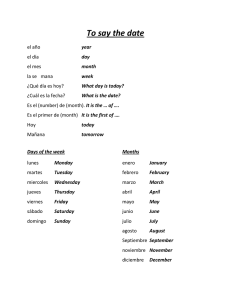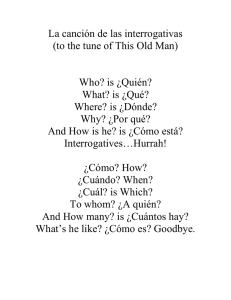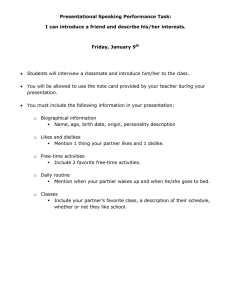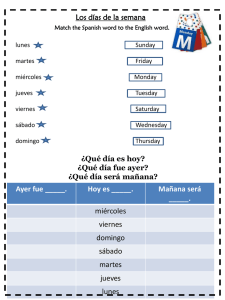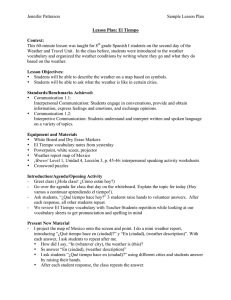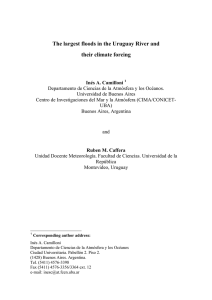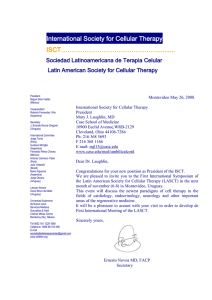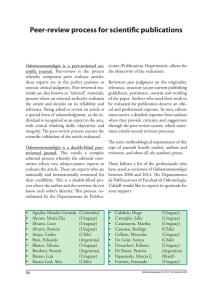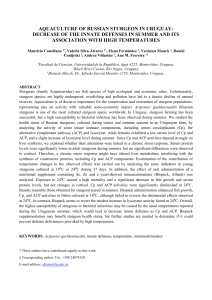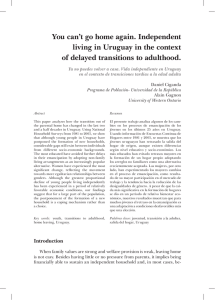Elementary School World Languages
Anuncio
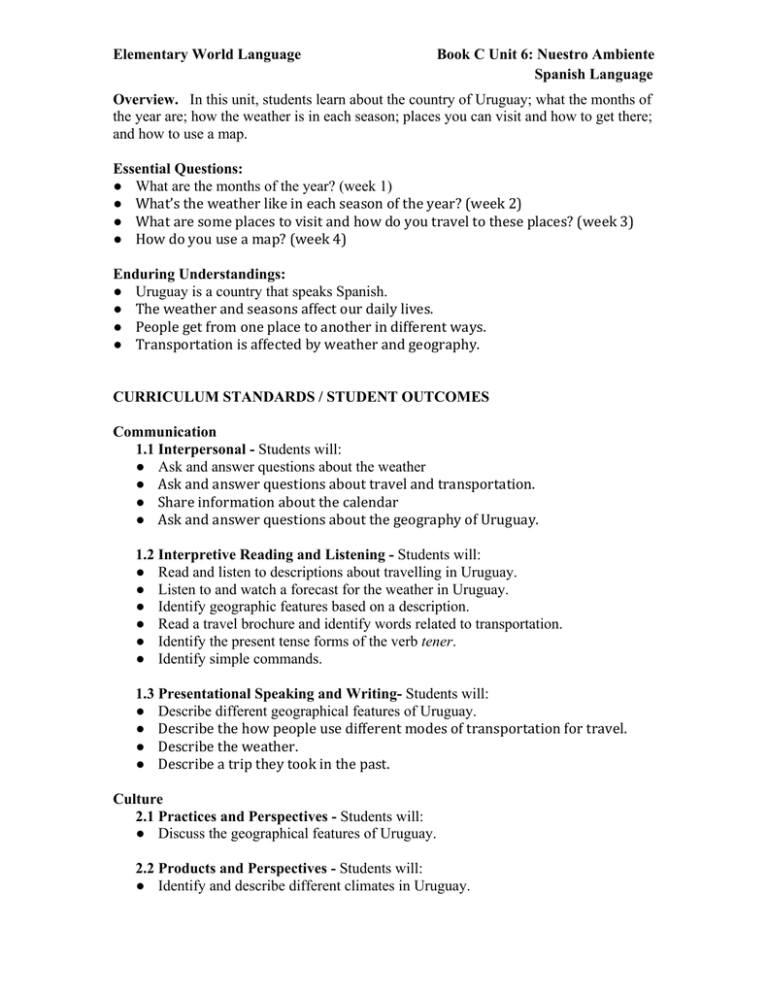
Elementary World Language Book C Unit 6: Nuestro Ambiente Spanish Language Overview. In this unit, students learn about the country of Uruguay; what the months of the year are; how the weather is in each season; places you can visit and how to get there; and how to use a map. Essential Questions: ● What are the months of the year? (week 1) ● What’s the weather like in each season of the year? (week 2) ● What are some places to visit and how do you travel to these places? (week 3) ● How do you use a map? (week 4) Enduring Understandings: ● Uruguay is a country that speaks Spanish. ● The weather and seasons affect our daily lives. ● People get from one place to another in different ways. ● Transportation is affected by weather and geography. CURRICULUM STANDARDS / STUDENT OUTCOMES Communication 1.1 Interpersonal - Students will: ● Ask and answer questions about the weather ● Ask and answer questions about travel and transportation. ● Share information about the calendar ● Ask and answer questions about the geography of Uruguay. 1.2 Interpretive Reading and Listening - Students will: ● Read and listen to descriptions about travelling in Uruguay. ● Listen to and watch a forecast for the weather in Uruguay. ● Identify geographic features based on a description. ● Read a travel brochure and identify words related to transportation. ● Identify the present tense forms of the verb tener. ● Identify simple commands. 1.3 Presentational Speaking and Writing- Students will: ● Describe different geographical features of Uruguay. ● Describe the how people use different modes of transportation for travel. ● Describe the weather. ● Describe a trip they took in the past. Culture 2.1 Practices and Perspectives - Students will: ● Discuss the geographical features of Uruguay. 2.2 Products and Perspectives - Students will: ● Identify and describe different climates in Uruguay. Elementary World Language Book C Unit 6: Nuestro Ambiente Spanish Language ● Identify the geographical features of Uruguay on a map. Connections 3.1 Cross-curricular - Students will: ● Identify geographical features. ● Identify geographic names and places to capitalize. ● Identify different climate regions of Uruguay. ● Learn how to segment and combine syllables. ● Identify and describe the weather conditions yesterday, today and tomorrow. 3.2 Target Culture - Students will: ● Acquire information about travelling through Uruguay through Spanish language media sources. Comparisons 4.1 Language - Students will: ● Compare words for transportation, weather, climate, geography and seasons between Spanish and English. ● Demonstrate one-to-one correspondence between spoken and printed word. ● Use and apply the present-tense forms of the verb tener. 4.2 Culture - Students will: ● Compare geographical features found in Uruguay with those found in the United States. ● Compare and contrast climate regions in Uruguay with those in the United States. ● Compare and contrast weather in Uruguay with weather in the United States. ● Compare and contrast common modes of transportation found in Uruguay with those found in the United States. Communities 5.1 Beyond the School - Students will: ● Participate in simulations that replicate authentic conversations about weather, geography, climate and transportation. 5.2 Lifelong Learner - Students will: ● Utilize the language to experience news and entertainment available through print and electronic Spanish language media. FUNCTIONS • VOCABULARY • STRUCTURES Elementary World Language LANGUAGE FUNCTION Name the months of the year. Identify time words such as today, yesterday and tomorrow. Name the days of the week. Identify the seasons of the year. Book C Unit 6: Nuestro Ambiente Spanish Language CONTENT VOCABULARY LANGUAGE STRUCTURE Months: ● mes ● enero ● febrero ● marzo ● abril ● mayo ● junio ● julio ● agosto ● septiembre ● octubre ● noviembre ● diciembre ● ● ● ● Time: ● ayer ● hoy ● mañana ● Ayer fue ● Hoy es ● Mañana será ● ● ● ● ● ● ● lunes martes miércoles jueves viernes sábado domingo Seasons: ● primavera ● verano ● otoño ● invierno ¿Qué mes es? Es (month). (Month). ¿Cuáles son los meses del año? ● ¿Cuáles son los meses de (estación)? ● Los meses son . . . ¿Qué día es hoy? Hoy es (día) ¿Qué día fue ayer? Ayer fue (día) ● ● ● ● ● ¿Qué estación es? Es (estación). ¿Qué estación te gusta? Me gusta (estación). ¿En qué estación ves (cosa)? ● (Estación). Describe the weather in each season. Weather: ● calor ● frío ● caluroso ● ¿Qué tiempo hace en cada estación del año? ● El tiempo en (estación) es (tiempo). Elementary World Language ● ● ● ● Book C Unit 6: Nuestro Ambiente Spanish Language fresco lluvioso nublado soleado ● ● ● ● ● ● ¿Cómo está el día? El día está (tiempo). ¿Qué tiempo hace? Hace frío/calor. ¿Cómo está el día hoy? Hoy el día está (tiempo). Discuss places they like to visit. Places: ● lago ● mar ● montaña ● río ● ¿Cuales son algunos lugares para visitar? ● Los (places). Identify means of transportation. Transportation: ● autobús ● avión ● barco ● bicicleta ● carro ● tren Ways of Travel: ● vía ● aire ● agua ● tierra ● calle ● ¿Cómo viajas? ● Yo viajo en (transportación). ● Me gusta viajar en (transportación). ● ¿Cómo viaja(n)? ● Viaja(n) en (transportación). ● ¿Cómo viajas a la escuela? ● Yo viajo a la escuela en (transportación) ● ¿Cómo viajas por (ambiente)? ● Yo viajo por (ambiente) en (transportación). Explain what maps are for. Purpose: ● mapa ● informe del tiempo ● meteorólogo ● país ● periódico ● tiempo ● aquí ● ¿Cómo usas un mapa? ● Usas un mapa para (purpose). Elementary World Language Book C Unit 6: Nuestro Ambiente Spanish Language
